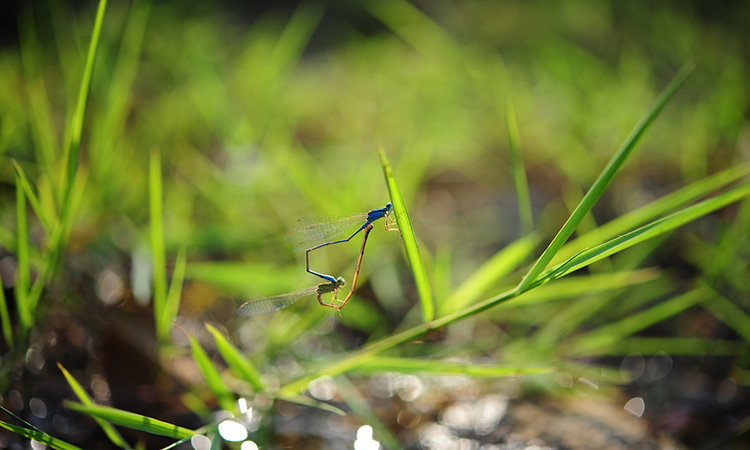A dragonfly is an insect belonging to the order Odonata, suborder Anisoptera. Adult dragonflies are characterized by large multifaceted eyes, two pairs of strong transparent wings, sometimes with coloured patches and an elongated body. Dragonflies can be mistaken for the related group, damselflies, which are similar in structure, though usually lighter in build; however, the wings of most dragonflies are held flat and away from the body, while damselflies hold the wings folded at rest, along or above the abdomen. Dragonflies are agile fliers, while damselflies have a weaker, fluttery flight. Many dragonflies have brilliant iridescent or metallic colours produced by structural coloration, making them conspicuous in flight. An adult dragonfly eye has nearly 24,000 ommatidia.
Fossils of very large dragonfly ancestors in the Protodonata are found from 325 million years ago (Mya) in Upper Carboniferous rocks; these had wingspans up to about 750 mm (30 in). About 3000 species of Anisoptera are in the world today. Most are tropical, with fewer species in temperate regions.
Dragonflies are predators, both in their aquatic larval stage, when they are known as nymphs or naiads, and as adults. Several years of their lives are spent as nymphs living in fresh water; the adults may be on the wing for just a few days or weeks. They are fast, agile fliers, sometimes migrating across oceans, and are often found near water. They have a uniquely complex mode of reproduction involving indirect insemination, delayed fertilization, and sperm competition. During mating, the male grasps the female at the back of the head or on the prothorax, and the female curls her abdomen under her body to pick up sperm from the male’s secondary genitalia at the front of his abdomen, forming the “heart” or “wheel” posture.
Loss of wetland habitat threatens dragonfly populations around the world. Dragonflies are represented in human culture on artifacts such as pottery, rock paintings, and Art Nouveau jewellery. They are used in traditional medicine in Japan and China, and caught for food in Indonesia. They are symbols of courage, strength, and happiness in Japan, but seen as sinister in European folklore. Their bright colours and agile flight are admired in the poetry of Alfred, Lord Tennyson and the prose of H. E. Bates.
Dragonflies and their relatives are an ancient group. The oldest fossils are of the Protodonata from the 325 Mya Upper Carboniferous of Europe, a group that included the largest insect that ever lived, Meganeuropsis permiana from the early Permian, with a wingspan around 750 mm (30 in); their fossil record ends with the Permian–Triassic extinction event (about 247 Mya). The Protoanisoptera, another ancestral group which lacks certain wing vein characters found in modern Odonata, lived from the Early to Late Permian age until the end Permian event, and are known from fossil wings from current day United States, Russia, and Australia, suggesting they might have been cosmopolitan in distribution. The forerunners of modern Odonata are included in a clade called the Panodonata, which include the basal Zygoptera (damselflies) and the Anisoptera (true dragonflies) Today there are some 3000 species extant around the world.
The relationships of anisopteran families are not fully resolved as of 2013, but all the families are monophyletic except the Corduliidae; the Gomphidae are a sister taxon to all other Anisoptera, the Austropetaliidae are a sister to the Aeshnoidea, and the Chlorogomphidae are a sister to a clade that includes the Synthemistidae and Libellulidae. On the cladogram, dashed lines indicate unresolved relationships; English names are given (in parentheses):
